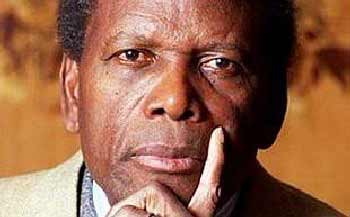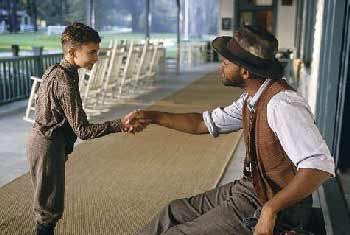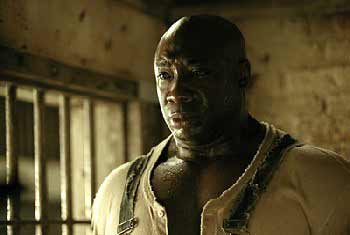Exposing Hollywood’s Fascination with the Magic Negro
Well, look at this. I’ve finally done it. If I didn’t get enough shit from parents of handicapped children a few years ago over the whole “retarded” thing, I’m bound to catch some flak for this one. But that’s me, the king of controversy. Or not. I’ve just been kind of bothered by this trend in movies for the last couple years, and felt I needed to get it off my chest.
You may be asking just what the hell I mean by “Magic Negro”. I didn’t make the term up, it’s something that gets tossed around quite a bit in film circles. Most recently, it was a term used by Spike Lee (more specifically, he referred to the ‘Super-Duper’ Magic Negro) to describe the trend when he first began to notice it and criticize it. What it is is an archetypal character that’s plagued Hollywood throughout the ages by great-white-hope filmmakers who feel it is their duty to paint some idea that the lower class wise black man or woman is there to serve as a mentor to the troubled upper class white man or woman. It’s stereotypical, outdated, and most importantly, racist as hell beneath the surface. There are several different levels of the Magic Negro archetype to be found in cinema, ranging from the subdued and likely unintentional to the blatantly obvious.
In a figurative sense, the Magic Negro can be a character with no supernatural powers at all, but rather one who gives advice or turns their charge’s life around through inspiration. An obvious example is Morgan Freeman’s character Red from THE SHAWSHANK REDEMPTION. While wrongfully imprisoned intelligent white man Andy Dufrense is facing the hardship of adapting to prison life, Red is there to guide him. While Red is uneducated, hardened, and guilty of the crime he’s in for; his wisdom gained from experience in the big house keeps Andy stable. Of course, the payoff is when the great white hope repays the Magic Negro at the end of the film, making all right with the world.

I like THE SHAWSHANK REDEMPTION. I think it’s a very well-made film. However, it’s brutally flawed and is so generically Hollywood in a lot of ways. I catch Hell every time I throw criticism its way, but my biggest criticism lies in the relationship between Red and Andy.
Another figurative example off the top of my head comes from AMERICAN HISTORY X. While Edward Norton’s Neo-Nazi skinhead Derek Vinyard is spending time in prison for the murder of two black youths, he befriends a fellow inmate, a black man by the name of Lamont (Guy Torry). Lamont is able to work the hatred right out of Derek, even going so far as to keep the other angry black inmates from harming him too badly, even though the guy killed two black youths in a hate crime. The example here is more or less preposterous, and would never happen in real life.
It’s seen so often these days that it often just goes unnoticed, but the stereotype abounds in even some of the most seemingly innocent of places. There are Magic Negroes of the figurative type in films such as THE HUDSUCKER PROXY, THAT THING YOU DO! (there’s a couple different ones in that one,) BULWORTH and THE SHINING. Oh yeah, and about every movie that Whoopi Goldberg has ever made. Lest we not forget THE MATRIX, in which The Oracle, the wisest of all the characters in the film, is portrayed as a stereotypical elderly black homemaker who bakes cookies. And I enjoyed all of these movies. Overall, they’re very well-made, but even the greatest of Hollywood’s players are apt to insert the stereotype in their works.

Of course, this isn’t exactly new ground in Hollywoodland. Not by a longshot. Just ask Sidney Poitier, who has basically made a career out of playing the archetype we’re talking about here. Now, I won’t discount Poitier in the slightest. The man is a legend. One of the finest actors to ever grace the screen, and a man who by all accounts is purely a class act. He is also instrumental in getting the foot in the door of segregated Hollywood for African-American actors, by being one of the first black actors to win starring roles in major motion pictures. However, he’s still got a handful of roles under his belt that qualify in the spectrum we’re talking here. Look no further than his role as an escaped convict in THE DEFIANT ONES. Or as a man who befriends a white blind girl in A PATCH OF BLUE. Of course, we are talking the 1950’s and 60’s here, when such blatant racial stereotypes were treated with less attention than they would be today. This was just the ideals of the liberal filmmakers of the time who thought their vision could change the world. Then again, I guess not much has changed after all.
Which leads us to the more spiritual, literal interpretation of the “Magic Negro”, which has become the apparent trend of recent months. This is the Whoopi Goldberg in CLARA’S HEART or Don Cheadle in THE FAMILY MAN type of Magic Negro: The one who actually really appears to be — gasp — magic. In fact, the year 1999 served up a pair of films that truly embodied the spirit of the Magic Negro to the absolute hilt. The two in particular are Robert Redford’s golfing drama THE LEGEND OF BAGGER VANCE and Frank Darabont’s adaptation of Stephen King prison tale THE GREEN MILE. Nowhere has the phenomenon been so apparent as it was with these two films, both of which created a lot of Oscar buzz (although only one garnered any nominations, and neither one won any.) These were the films that likely caused folks like Spike Lee to become so critical of Hollywood’s archaic racist fantasies, and got the ball rolling again with the “Magic Negro” terminology, which was tossed around in the 1950’s, but came to mean something far more literal in these films.

In the depression-era BAGGER VANCE, Will Smith plays a poor uneducated black man, sharing his name with the title of the film, who offers his services as a caddy to Matt Damon’s Rannulph Junuh, a legendary golfer before a stint in World War I left him disheveled and less of a player. As the film progresses, we see that Bagger Vance seems to possess more than someone in his position should. Almost showing that he has supernatural powers, he is able to read the greens and guide Junuh back toward achieving his game. He becomes a spiritual mentor, guiding the hapless player back through his trials and tribulations, almost as if he were Yoda to Damon’s Luke Skywalker. We’re led to believe the possibility that Bagger is not really a man at all, but perhaps a guardian angel placed on Earth to guide the well-to-do white man back to prosperity, and then disappear without a trace.

In THE GREEN MILE, we once again see the combination of director Frank Darabont, writer Stephen King, a prison setting, and a Magic Negro. Hey, it worked for SHAWSHANK, so why not try to repeat the process? In this 3+ hour piece of Oscarbait, Michael Clarke Duncan stars as John Coffey, an abnormally large black man sentenced to death for the murder of two white children in the 1930’s. Wrongfully accused, John is afraid of the dark, cannot read or write, and seems to be the gentlest of giants. Over time, Coffey’s true self begins to shine, as he appears to have healing powers that affect not only mice, but his fellow prisoners and guards. The relationship that well-to-do white prison guard Paul Edgecomb (Tom Hanks) has with Coffey gives Edgecomb a new outlook on life, after being hardened by watching criminals being put to death.
While most people took these films at face value, there was a contingent out there that saw a dangerous trend — one of an old-fashioned type of racially charged thinking that seems purely innocent on the outside. The fact that these stories all seemed to be penned and directed by primarily white men, while all featuring a relationship that seems to only benefit and enhance the white character, while leaving the “Magic Negro” as a one-dimensional stereotype, all are taken into consideration. It’s the reverse of the “Great White Hope” syndrome, in which the white character comes in and changes the lives of the less-educated minority (see: DANGEROUS MINDS, A TIME TO KILL, THE GHOSTS OF MISSISISSIPI, et al.), but it’s just as offensive.
And believe me, I’m the last one to run around calling “racism!” at everything. I’m the one who understands the idea of diversity, individuality, and the way relationships between people of different backgrounds can sometimes be less-than-perfectly formed. It’s when these white pseudo-intellectual wannabe, typically liberal Hollywood types get out there and think they can change the world by painting fantasy worlds where the black man is a one-dimensional wise man and the white man can only be enriched and move on that I just cringe.
I’m sure the archetype won’t go away anytime soon. After all, it lures moviegoers in, makes them feel more intellectual and understanding, and scores big with award ceremony voters (the Academy loves folks with afflicions.) I just hope folks can see through the one-dimensional stereotypes and think clearly in their moviegoing exploits.

 subscribe to rss
subscribe to rss 




















nice site you have, thanks for sharing, have a look at http://badmovieknights.com/ when you get time :>
I think magical negroes are due to stinky salami on the western hemisphere. Madam maxine is a negro , for example. Charlie Baker fancies himself a philosopher if he can back that thang up.
signed: The human papaloma virus
“even though the guy killed two black youths in a hate crime.”
no, he killed two street gang members who were trying to steal his car. In one scene you see the school principal talking about Derek and he says the two nggers were Crips (or Bloods). Nobody in his right mind should feel sorry for the Crips or the Bloods given that they are vile scumbags but that’s what the writer wanted us to feel by showing Derek’s evil face after the curb stomp
Well done and very accurate. This topic is growing by the day as politicoes start to apply it to our new president. To Chris: I didn’t know that grand theft auto warranted death. Your argument is pitiful;your insight nonexistent.
I really wonder why you lead off with shawshank because i think is fits the profile least of all. Red isn’t magic nor does he serve Andy in any self-deprecating or self sacrificing way. He does posses some social cache that allows him to get some consumer goods but Andy alludes to red having competitors so this isn’t anything particularly special or unique to Red.
Magic negroes turn up a lot in stephen king’s work. But in the novel of shawshank Red is a white man. I think that morgan freeman playing him has more to do with morgan freeman just being a good actor and a big enough star to be able to play a part that racial identity isn’t a big part of than him being black.
I found this article after thinking Red may be a magical negro. And the argument exists and you’ve posed it well, but you’ve neglected to mention that Andy’s presence in Shawshank is as fulfilling for Red as Red’s presence for Andy. I agree with David.
Leave your response!
Follow us on your favorite Social Network:
Link to us!
Site Friends:
The Belligerent Monkey
Wrestling With Pop Culture
Third Half Studios
Earth Station One
Mentally Incontinent
The Sci-Fi Movie Page
IMSDB
Monthly Archives
Categories
Tags
Most Commented
Recent Comments